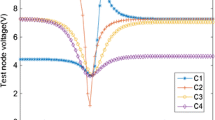Abstract
A novel multidimensional fitness function genetic algorithm is proposed to optimize test vectors of R-2R Digital-to-Analog Converters (DAC). The proposed method employs distribution of characteristic vectors and the number of test vectors to formulate a multidimensional fitness function to search a non-dominate (ND) solution set. The searching process is directed by a ND sort method. Each individual in the ND set does not contain redundant test vectors. The test vectors are taken as the input excitation of the circuit under test (CUT) and the fault diagnosis is performed. As the number of test vectors increases, the accuracy of fault diagnosis also increases. The validity of the proposed method is verified by fault diagnosis. The average fault diagnosis rate is more than 85% for the R-2R network under the influence of tolerance. In addition, the parametric faults of \(\pm 50\mathbf{\%}\) deviation from the nominal value in each resistor of the R-2R network can be detected in the proposed method. Finally, the comparative experiments and results are briefly described in this paper.













Similar content being viewed by others
Data Availability Statement
The datasets supporting the conclusions of this article are included within the article and its additional files.
References
Burdiek B (2001) Generation of optimum test stimuli for nonlinear analog circuits using nonlinear programming and time-domain sensitivities. Proceedings Design, Automation and Test in Europe Conference and Exhibition, p 603–608
Coyette A Esen, B, Dobbelaere W, Vanhooren R, Gielen G (2016) Automatic Test Signal Generation for Mixed-Signal Integrated Circuits using Circuit Partitioning and Interval Analysis. In: 2016 IEEE International Test Conference, p 1–10
Deb K (1999) Multi-objective Genetic Algorithms: Problem Difficulties and Construction of Test Problems. Evol Comput 7(3):205–230
Deb K, Agrawal RB (1994) Simulated Binary Crossover for Continuous Search Space. Complex Syst 9(3):115–148
Golonek T, Rutkowski J (2007) Genetic-algorithm-based method for optimal analog test points selection. IEEE Trans Circuits Syst II Express Briefs 54(2):117–121
Huang WH, Wey CL (1998) ATPRG: An automatic test program generator using HDL-A for fault diagnosis of analog/mixed-signal integrated circuits. IEEE Trans Instrum Meas 47(2):426–431
Huynh SD, Kim S, Soma M, Zhang JY (1999) Automatic analog test signal generation using multifrequency analysis. IEEE Trans Circuits Syst II Express Briefs 46(5):565–576
Kerkhoff HG (2005) The test search for true mixed-signal cores. Microelectron J 36(12):1103–1111
Khanlari M, Ehsanian M (2020) A test point selection approach for DC analog circuits with large number of predefined faults. Analog Integr Circuits Signal Process 102(1):225–235
Ma QF, He YZ, Zhou FQ, Song P (2018) Test Point Selection Method for Analog Circuit Fault Diagnosis Based on Similarity Coefficient. Math Probl Eng 2018:1–11
Nagamani AN, Anuktha SN, Nanditha N, Agrawal VK (2018) A Genetic Algorithm-Based Heuristic Method for Test Set Generation in Reversible Circuits. IEEE Trans Comput Aided Des Integr Circuits Syst 37(2):324–336
Ramadoss R, Bushnell ML (1999) Test generation for mixed-signal devices using signal flow graphs. J Electron Test Theory Appl 14(3):189–205
Sindia S, Singh V, Agrawal VD (2009) Multi-Tone Testing of Linear and Nonlinear Analog Circuits using Polynomial Coefficients. In: 2009 Asian Test Symposium, p 63–68
Slamani M, Kaminska B (1996) Fault observability analysis of analog circuits in frequency domain. IEEE Trans Circuits Syst II Analog Digit Signal Process 43(2):134–139
Tian Y, Si L, Zhang X, Cheng R, He C, Tan K, Jin Y (2021) Evolutionary Large-Scale Multi-Objective Optimization: A Survey. ACM Comput Surv 1(1)
Vargha B, Zoltan I (2001) Calibration algorithm for current-output R-2R ladders. IEEE Trans Instrum Meas 50(5):1216–1220
Voyiatzis I, Gizopoulos D, Paschalis A (2005) Accumulator-based test generation for robust sequential fault testing in DSP cores in near-optimal time. IEEE Trans Very Large Scale Integr VLSI Syst 13(9):1079–1086
Wang H, Wu Z, Rahnamayan S (2011) Enhanced opposition-based differential evolution for solving high-dimensional continuous optimization problems. Soft Comput 15(11):2127–2140
Wang L, Fukatsu Y, Watanbe K (2001) Characterization of current-mode CMOS R-2R ladder digital-to-analog converters. IEEE Trans Instrum Meas 50(6):1781–1786
Wang P, Gharehbaghi AM, Fujita M (2020) An Automatic Test Pattern Generation Method for Multiple Stuck-At Faults by Incrementally Extending the Test Patterns. IEEE Trans Comput Aided Des Integr Circuits Syst 39(10):2990–2999
Yang C, Zhen L, Hu C (2019) Fault Diagnosis of Analog Filter Circuit Based on Genetic Algorithm. IEEE Access 7:54969–54980
Yang CL, Tian SL, Long B, Chen F (2010) A test points selection method for analog fault dictionary techniques. Analog Integr Circuits Signal Process 63(2):349–357
Yuan J, Tachibana M (2013) A resistance matching based self-testable current-mode R-2R digital-to-analog converter. IEICE Electron Express 10(23):20130753
Zhao DS, He YZ (2015) A New Test Point Selection Method for Analog Circuit. J Electron Test Theory Appl 31(1):53–66
Acknowledgements
This work was supported in part by the Open Foundation of Guangxi Key Laboratory of Automatic Detecting Technology and Instruments under Grant No. YQ18207 and the National Natural Science Foundation of China under Grants No. U1830133.
Author information
Authors and Affiliations
Corresponding author
Ethics declarations
Conflict of Interest Statement
We declare that we have no financial and personal relationships with other people or organizations that can inappropriately influence our work, there is no professional or other personal interest of any nature or kind in any product, service and/or company that could be construed as influencing the position presented in, or the review of, the manuscript entitled.
Additional information
Responsible Editor: S. Sunter
Publisher's Note
Springer Nature remains neutral with regard to jurisdictional claims in published maps and institutional affiliations.
Rights and permissions
About this article
Cite this article
Yang, X., Yang, C. & Wang, H. A Test Generation Method of R-2R Digital-to-Analog Converters Based on Genetic Algorithm. J Electron Test 37, 701–713 (2021). https://doi.org/10.1007/s10836-021-05974-w
Received:
Accepted:
Published:
Issue Date:
DOI: https://doi.org/10.1007/s10836-021-05974-w




